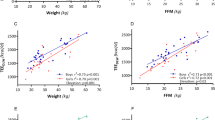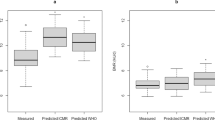Abstract
Objective:
To measure total energy expenditure (TEE) for normal healthy Japanese by the doubly labelled water (DLW), and to compare the physical activity level (PAL) among categories classified by the categories used in daily reference intake (DRI), Japan and the International Physical Activity Questionnaire (IPAQ).
Subjects and methods:
A total of 150 healthy Japanese men and women aged 20- to 59-year-old living in four districts of Japan. TEE was measured by the DLW method, and the PAL was calculated from TEE divided by basal metabolic rate. Simultaneously with TEE measurement, the PAL was assessed employing the categories used in DRI, Japan and IPAQ.
Results:
The average TEE and PAL were 10.78±1.67 MJ/day and 1.72±0.22 for males and 8.37±1.30 MJ/day and 1.72±0.27 for females, respectively. The subjects in the highly active categories assessed by both DRI and IPAQ showed significantly higher PAL compared with less active categories. However, PALs among light and moderate categories by DRI, and insufficient and sufficiently active by IPAQ were not significantly different.
Conclusions:
In developed countries, highly active subjects could be assessed by a simple questionnaire. However, the questionnaire should be improved to clarify the sedentary to moderately active subjects by assessing carefully very light to moderate physical activity.
This is a preview of subscription content, access via your institution
Access options
Subscribe to this journal
Receive 12 print issues and online access
$259.00 per year
only $21.58 per issue
Buy this article
- Purchase on Springer Link
- Instant access to full article PDF
Prices may be subject to local taxes which are calculated during checkout
Similar content being viewed by others
References
Black AE, Coward WA, Cole TJ, Prentice AM (1996). Human energy expenditure in affluent societies: an analysis of 574 doubly-labelled water measurements. Eur J Clin Nutr 50, 72–92.
Black AE, Prentice AM, Coward WA (1986). Use of food quotients to predict respiratory quotients for the doubly labelled water method of measuring energy expenditure. Hum Nutr Clin Nutr 40C, 381–391.
Brooks GA, Butte NF, Rand WM, Flatt JP, Caballero B (2004). Chronicle of the Institute of Medicine physical activity recommendation: how a physical activity recommendation came to be among dietary recommendations. Am J Clin Nutr 79 (Suppl), 921S–930S.
Ebine N, Shimada M, Tanaka H, Nishimuta M, Yoshitake Y, Saitoh S et al. (2002). Comparative study of total energy expenditure in Japanese men using doubly labeled water method against activity record, heart rate monitoring, and accelerometer methods. Jpn J Phys Fitness Sport Med 51, 151–164. (in Japanese with English abstract).
Frankenfield D, Roth-Yousey L, Compher C (2005). Comparison of predictive equations for resting metabolic rate in healthy nonobese and obese adults: a systematic review. J Am Diet Assoc 105, 775–789.
Ganpule AA, Tanaka S, Ishikawa-Takata K, Tabata I (2007). Interindividual variability in sleeping metabolic rate in Japanese subjects. Eur J Clin Nutr advance online publication.
Graig CL, Marshall AL, Sjostrom M, Bauman AE, Booth ML, Ainsworth BE et al. (2003). International physical activity questionnaire: 12-country reliability and validity. Med Sci Sports Exerc 35, 1381–1395.
Hayter JE, Henry CJ (1993). Basal metabolic rate in human subjects migrating between tropical and temperate regions: a longitudinal study and review of previous work. Eur J Clin Nutr 47, 724–734.
Heyward VH, Wagner DR (2004). Body composition reference methods. In: Applied Body Composition Assessment. Human Kinetics:. pp 27–47.
Japan Society for the Study of Obesity (2006). Guideline for the treatment of obesity. J Jpn Soc Study of Obes 32, 10–15. (in Japanese).
Jones PJH, Leitch CA (1993). Validation of doubly labeled water for measurement of calorie expenditure in collegiate swimmers. J Appl Physiol 74, 2909–2914.
Kempen KPG, Saris WHM, Westerterp KR (1995). Energy balance during an 8-wk energy-restriction diet with and without exercise in obese women. Am J Clin Nutr 62, 722–729.
Lamonte MJ, Ainsworth BE (2001). Quantifying energy expenditure and physical activity in the context of dose response. Med Sci Sports Exerc 33, S370–S378.
Levine JA (2004). Nonexercise activity thermogenesis (NEAT): environment and biology. Am J Physiol Endocrinol Metab 286, E675–E685.
Levine JA, Lanningham-Foster LM, McCrady SK, Krizan AC, Olson LR, Kane PH et al. (2005). Interindividual variation in posture allocation: possible role in human obesity. Science 307, 584–586.
Ministry of Health, Labour and Welfare, Japan (1999). Recommended Dietary Allowances for the Japanese 6th edn. Ministry of Health, Labour and Welfare, Japan.
Ministry of Health, Labour and Welfare, Japan (2000). The National Nutrition Survey, Japan, 1998. Ministry of Health, Labour and Welfare, Japan.
Ministry of Health, Labour and Welfare, Japan (2006). The National Nutrition Survey in Japan, 2003. Ministry of Health, Labour and Welfare, Japan.
Montoye HJ, Kemper HCG, Saris WHM, Washburn RA (1996). Measuring Physical Activity and Energy Expenditure. Human Kinetics, Champion, IL.
Murase N, Katsumura T, Ueda C, Inoue S, Shimomitsu T (2002). International standardization of physical activity. Kosei no Shihyo 49, 1–9. (in Japanese).
NHK Broadcasting Culture Research Institute (2001). National Time Use Survey 2000 Report. NHK Service Center: Tokyo, Japan.
Peng H, Saito S, Hikihara Y, Ebine N, Yoshitake Y (2005). Energy expenditure, body composition and maximal oxygen uptake in middle-aged Japanese women who have long-term habits of exercising. Jpn J Phys Fitness Sports Med 54, 237–248. (in Japanese with English abstract).
Prentice AM, Black AE, Coward WA, Cole TJ (1996). Energy expenditure in overweight and obese adults in affluent societies: an analysis of 319 doubly-labelled water measurements. Eur J Clin Nutr 50, 93–97.
Racette SB, Schoeller DA, Luke AH, Shay K, Hnilicka J, Kushner RF (1994). Relative dilution spaces of 2H- and 18O-labeled water in humans. Am J Physiol 267, E585–E590.
Rafamantanantsoa HH, Ebine N, Yoshioka M, Yoshitake Y, Tanaka H, Saitoh S et al. (2003). The role of exercise physical activity in varying the total energy expenditure in healthy Japanese men 30 to 69 years of age. J Nutr Sci Vitaminol 49, 120–124.
Sasaki S, Yanagibori R, Amano K (1998a). Self-administered diet history questionnaire developed for health education: a relative validation of the test-version by comparison with 3-day diet record in women. J Epidemiol 8, 203–215.
Sasaki S, Yanagibori R, Amano K (1998b). Validity of a self-administered diet history questionnaire for assessment of sodium and potassium. Comparison with single 24-h urinary excretion. Jpn Circ J 62, 431–433.
Schoeller DA, Shay K, Kushner RF (1997). How much physical activity is needed to minimize weight gain in previously obese women? Am J Clin Nutr 66, 551–556.
Schulz LO, Schoeller DA (1994). A compilation of total daily energy expenditures and body weights in healthy adults. Am J Clin Nutr 60, 676–681.
Surrao J, Sawaya AL, Dallal GE, Tsay R, Roberts SB (1998). Use of food quotient in human doubly labeled water studies: comparable results obtained with 4 widely used food intake methods. J Am Diet Assoc 98, 1015–1020.
Taguchi M, Higuchi M, Oka J, Yoshiga C, Ishida Y, Matsushita M (2001). Basal metabolic rate in Japanese female endurance athletes. Jpn J Nutr 59, 127–134. (in Japanese with English abstract).
Tanaka S, Tanaka C, Futami J, Oka J, Ishikawa-Takata K, Kashiwazaki H (2003). Twenty-four-hour energy expenditure of adults in sedentary life measured using indirect human calorimeter. J Jpn Soc Nutr Food Sci 56, 291–296.
Vanhees L, Lefevre J, Philippaerts R, Martens M, Huygens W, Troosters T et al. (2005). How to assess physical activity? How to assess physical fitness? Eur J Cardiovasc Prev Rehabil 1, 102–114.
Weinsier RL, Hunter GR, Desmond RA, Byme NM, Zuckerman PA, Darnell BE (2002). Free-living activity energy expenditure in women successful and unsuccessful at maintaining a normal body weight. Am J Clin Nutr 75, 499–504.
Weir JBDV (1949). New methods for calculating metabolic rate with special reference to protein metabolism. J Physiol 109, 1–9.
Westerterp KR (2001). Pattern and intensity of physical activity. Nature 410, 539.
Westerterp KR (2003). Impacts of vigorous and non-vigorous activity on daily energy expenditure. Proc Nutr Soc 62, 645–650.
Wolfe RR (1992). Measurement of total energy expenditure using the doubly-labeled water method. In: Wolfe RR (ed). Radioactive and Stable Isotope Tracers in Biomedicine. Wiley-Liss Inc.: New York. pp 207–233.
World Health Organization (1997). Obesity: Preventing and Managing the Global Epidemic. World Health Organization: Geneva.
Yamamura C, Tanaka S, Futami J, Oka J, Ishikawa-Takata K, Kashiwazaki H (2003). Activity diary method for predicting energy expenditure as evaluated by a whole-body indirect human calorimeter. J Nutr Sci Vitaminol 49, 262–269.
Author information
Authors and Affiliations
Corresponding author
Additional information
Guarantor: K Ishikawa-Takata.
Contributors: KIT had the original idea, supervised IRMS analyses, analyzed the data, wrote the first draft and edited subsequent versions. IT supervised the study and edited the manuscript. SS supervised the field data collection and edited the manuscript. HHR and H Okazaki participated in the field data collection and IRMS analyses and edited the manuscript. H Okubo managed the field measurements and edited the manuscript. ST participated in the data analyses and edited the manuscript and SY, TS, KU and MM participated in field measurements and edited the manuscript.
Rights and permissions
About this article
Cite this article
Ishikawa-Takata, K., Tabata, I., Sasaki, S. et al. Physical activity level in healthy free-living Japanese estimated by doubly labelled water method and International Physical Activity Questionnaire. Eur J Clin Nutr 62, 885–891 (2008). https://doi.org/10.1038/sj.ejcn.1602805
Received:
Revised:
Accepted:
Published:
Issue Date:
DOI: https://doi.org/10.1038/sj.ejcn.1602805
Keywords
This article is cited by
-
Distribution of water turnover by sex and age as estimated by prediction equation in Japanese adolescents and adults: the 2016 National Health and Nutrition Survey, Japan
Nutrition Journal (2023)
-
Utility of the low physical activity questionnaire for hemodialysis patients with frailty: a cross-sectional study
Renal Replacement Therapy (2023)
-
Cross-cultural adaptation and validation of the rapid assessment of physical activity questionnaire (RAPA) in Hungarian elderly over 50 years
BMC Sports Science, Medicine and Rehabilitation (2022)
-
Association of physical activity with sarcopenia evaluated based on muscle mass and strength in older adults: 2008–2011 and 2014 − 2018 Korea National Health and Nutrition Examination Surveys
BMC Geriatrics (2022)
-
The predictors of health-enhancing physical activity among working women in Singapore two years into COVID-19: a cross-sectional study
Scientific Reports (2022)



